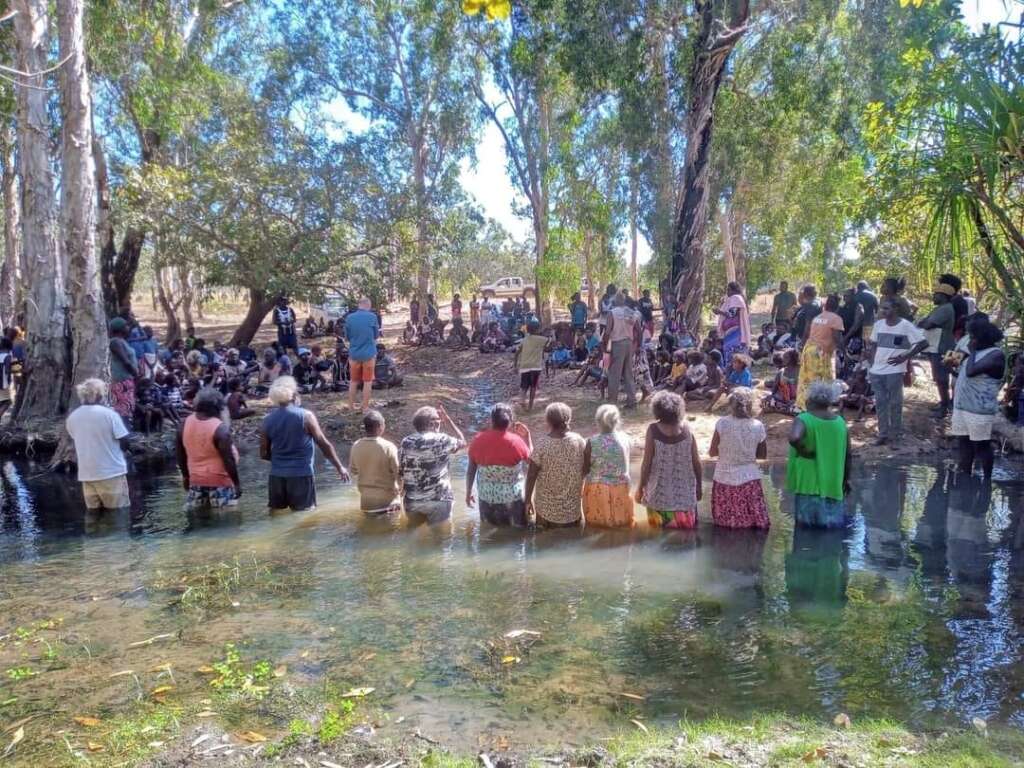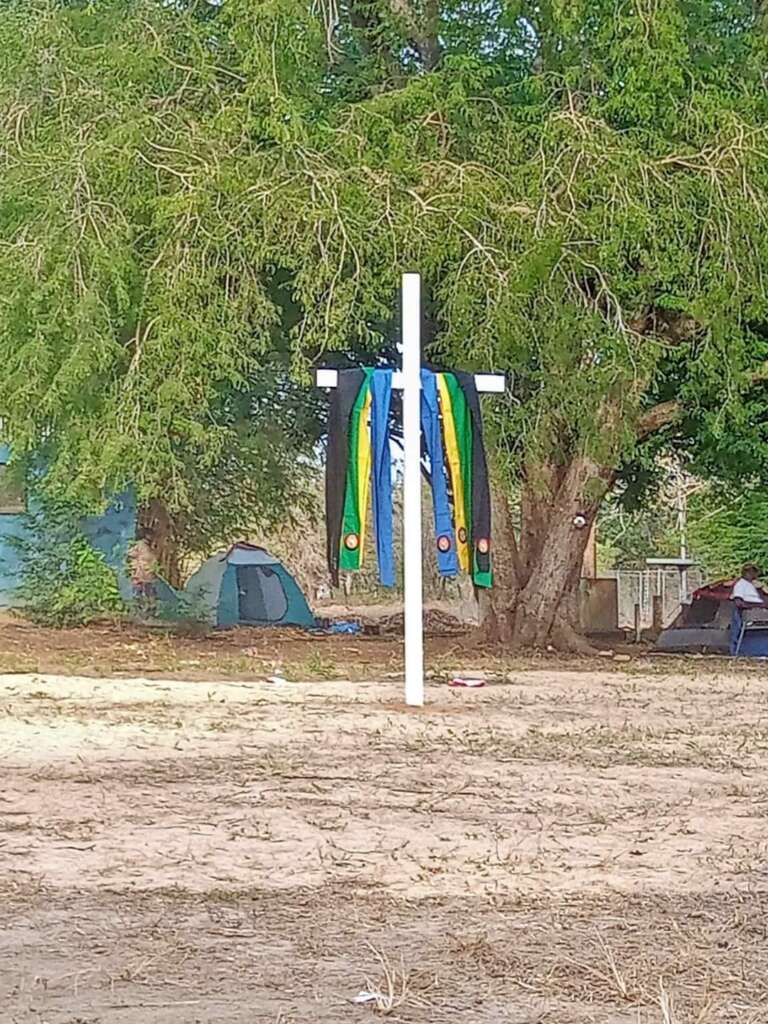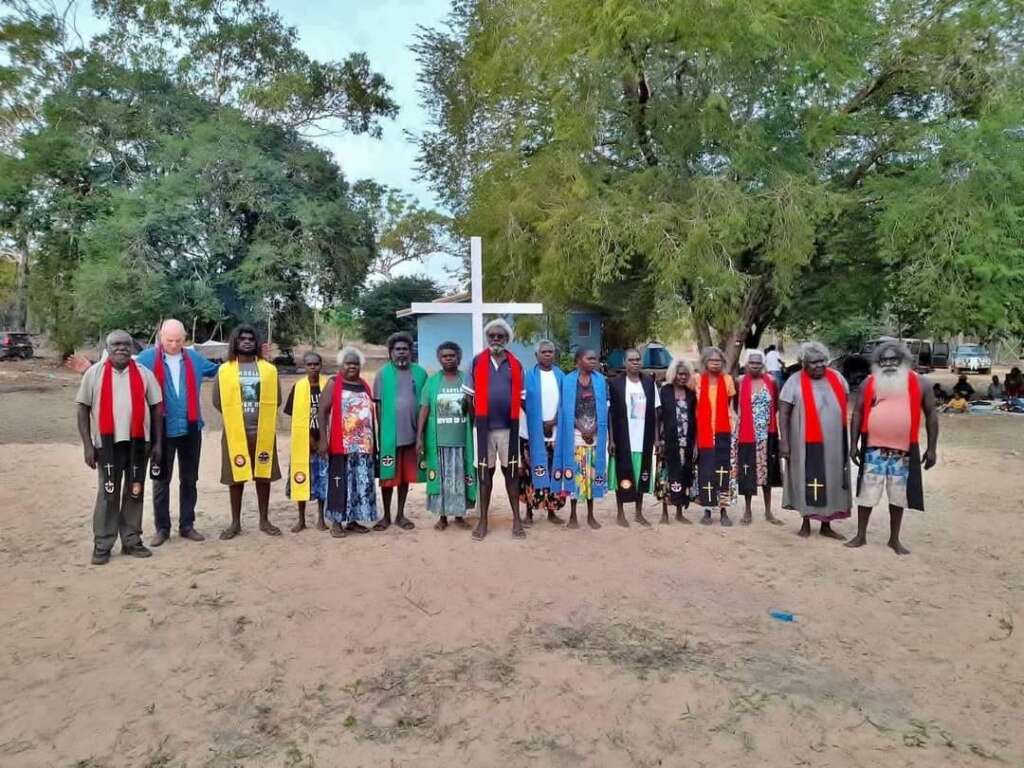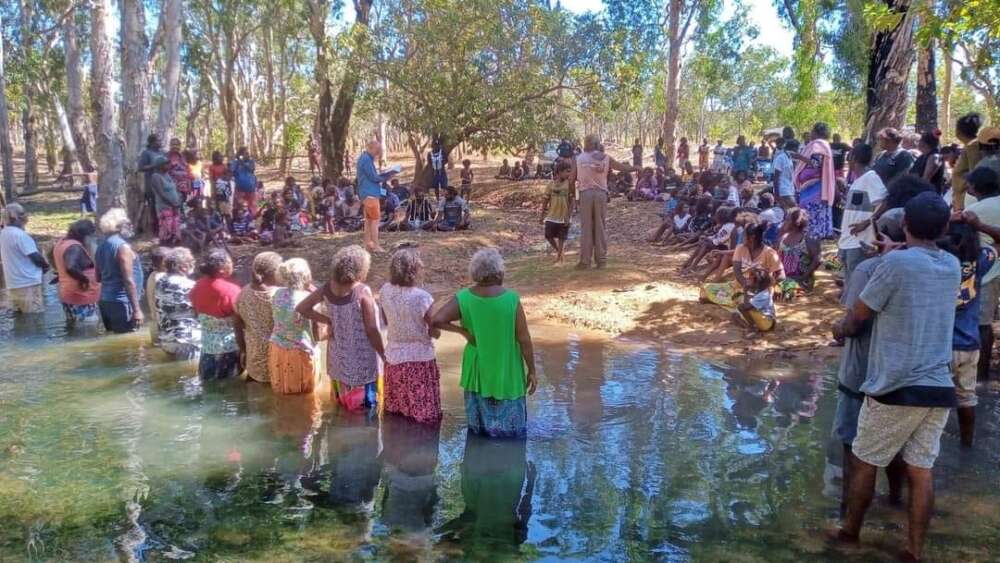Cross dedication attracts 130 baptisms in Arnhem Land
Large numbers of Aboriginal people came forward for baptism in the Caddell River at a recent cross dedication ceremony at Gochan Jiny-jirra – Caddell Homeland, about 38km southeast of Maningrida in Western Arnhem Land.
“The Holy Spirit is working in Western Arnhem Land,” exclaims Lindsay Parkhill, a bush chaplain for Frontier Services an agency of the Uniting Church.
In a cross dedication ceremony, wooden crosses are raised on homelands to bless the country and renew the covenant between God and the Holy Spirit in the land. The sacraments of the church – baptism and communion – are also performed. Lindsay took a supportive role in the recent ceremony and is planning many more with pastors, elders and leaders in Western Arnhem Land.

130 people are baptised in the Caddell River at a recent cross dedication ceremony at Gochan Jiny-jirra.
The cross dedication at Caddell also featured the recognition of eight ministry leaders – elders, music leaders, youth leaders and pastoral care workers, which prompted tears from those present. Other cross dedication ceremonies are planned at Mumeka, Mudginberri, Ngakalawarra, Kewelyi, Karrata and other Homelands.
“Cross dedication is a ceremony that has a long tradition in Western Arnhem Land, probably dating back to the 70s,” explains Lindsay, whose ministry is based in Jabiru in the heart of Kakadu National Park.
“More recently, we’ve been holding cross dedication ceremonies in homelands, on people’s ancestral estates. Planting a cross in the ground is a significant ceremonial activity and it’s treated with great reverence and significance by the inhabitants of the Homelands.”

The cross is planted in the ground to bless the country and renew the covenant with God.
The ceremony lasts from three days up to a week, preparing people for baptism and then baptising them by immersion in living water just as instructed in the Didache (the teaching of the 12 Apostles).
While baptising 130 people is a record, Lindsay said it was not uncommon to have 60 or 70 people from infants to old people being born again.
“We baptised 64 bininj [Aboriginal people of Western Arnhem land] just down the road here at Jabiru at Budabudayiw. It’s not uncommon for there to be many people. The beauty of it is that the baptisms are done by familial elders and leaders, so it’s a sort of a relationship thing. People baptise their relations, which is a really beautiful thing,” he says.
“My role is supportive. I read out the names and issue the baptism certificates. They will be distributed when we have a rally at Maningrida at the end of this month.”
“They have that sense of equity and sense of hospitality that has been largely bred out of us whitefellas since the Enlightenment.”
Lindsay believes the First Nations Christians in Arnhem Land have a great deal to teach the wider church “if the wider church could only listen.”
“They’re more Christian than we are, according to the dictates of Acts, sharing possessions and worshipping regularly. The Spirit of our living God is alive seven days a week, not just on Sundays.
“What I say is that bininj are Old Testament people, tribal people, resting on the firm foundations of Jesus. They have that sense of equity and sense of hospitality that has been largely bred out of us whitefellas since the Enlightenment.
The sense of relationship, it’s building respect and relationship rather than directorial imperative. There is consensus decision making, unlike the pyramidical structure of the dominant culture – it’s a much flatter form of organisation.”

Lindsay Parkhill, second left, with some of the newly baptised.
Lindsay says the importance and vitality of Christianity in Arnhem Land is that it’s the longest consistent connection with balanda, with whitefellas, that Aboriginal bininj people have had.
“Governments come and go, bureaucrats come and go, but the church is a long connection and it is a consistent connection. The teachings of the Bible are consistent and Christian people are leaders in their communities. That’s just the way of it.”
“It was through my immersion and exposure to arrarrkpi people on Goulburn Island that I came to faith.”
Lindsay came to faith living and working with arrarrkpi, (Mawng-speaking people), particularly his tribal brother, Pastor Billy Nawaloinba.
“I first came up here in 1988 as a secular community development worker. It was through my immersion and exposure to arrarrkpi people on Goulburn Island that I came to faith through living and working with Indigenous people,” he says.
“While I was a community development worker, I was asked to pray at the bedside of an old lady called Mayabiyn, who was the last living person who could remember the arrival of the Reverend James Watson in 1916. [In June 1916 James Watson arrived at Warruwi (South Goulburn Island) off the coast of the Northern Territory to establish a Christian mission to the Aboriginal people.]
“I was asked to pray at her bedside. She was dying. I come from a Christian family and so I started praying the Lord’s Prayer. And then I had a strange experience which I would equate with Wesley’s ‘strangely warmed heart’. That was my Damascus Road experience, if you like.”
“I wasn’t blinded by the light or anything. It was just an experience that made me question existence. Before, the world had not been a mystery. Now, there was a mysterious element in this world which I had to explore.”
“Before, the world had not been a mystery. Now, there was a mysterious element in this world which I had to explore.”
Over the next few years, Lindsay spent time down Roper River and Ngukurr and worked as a teacher-linguist at Willowra, which is the ancestral Homeland of the Warlpiri people where he had another epiphany that dragged him “kicking and screaming” to theological college.
“We drove down to Yuendumu to camp in the dump, which is where the Willowra people camped. And there was an Easter palapa, a ceremony. The Warlpiri have this fantastic ceremony for Easter, in which they do traditional dancing and perform the Easter story. It was after going through that experience that I finally resolved to go to theological college and study for the ministry and be ordained.
“I spent five years in Melbourne doing theology at the United Faculty of Theology which is dissolved now, but it was a coalition between the Jesuits, the Anglican church and the Uniting Church. It was a fantastic institution. We had access to the Jesuit library, and some of my best teachers were Jesuits, especially in Hebrew and Old Testament.”
Since returning to Jabiru in 2009, Lindsay has never considered moving on.
“Well, I’m part of the family; nawayuk at Warruwi, nakojok at Jabiru, wamut at Maningrida, mambali down the Roper and Japangardi in the desert,” he says to explain what keeps him motivated. “I just consider myself so fortunate to be able to share in people’s lives.”
“I just consider myself so fortunate to be able to share in people’s lives.”
Lindsay supports 22 pastors in an area from the Blythe River in the east, to the Coburg Peninsula in the west, and works with the Northern Regional Council of the Uniting Aboriginal and Islander Christian Congress (UAICC) to develop local church leadership.
While cross dedications have so far been confined to Western Arnhem Land, Lindsay said there is now interest from communities in Eastern Arnhem Land to hold their own.
“There’s been a request from Alan Maratja Dhamarrandji for a cross dedication at Garrata Homeland, north of Gapuwiyak,” he says.
“That is good because the thing about cross dedications is that they authenticate the whole Homeland Movement. And it’s a counterpoint to the desire of the dominant culture to draw everybody into central hubs like Gunbalanya and Maningrida and places like that. The whole Homeland movement has been white-anted by successive governments since Whitlam.”
Email This Story
Why not send this to a friend?




